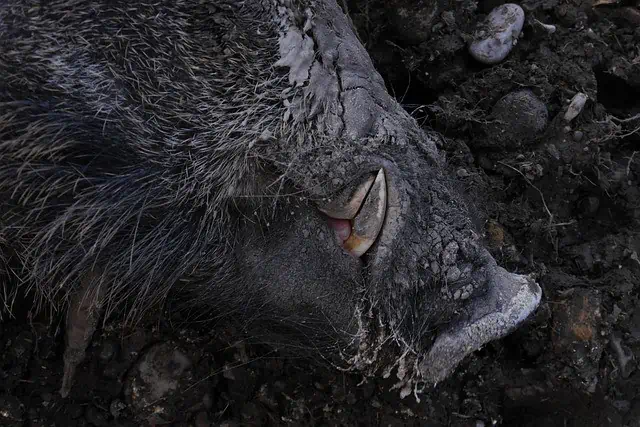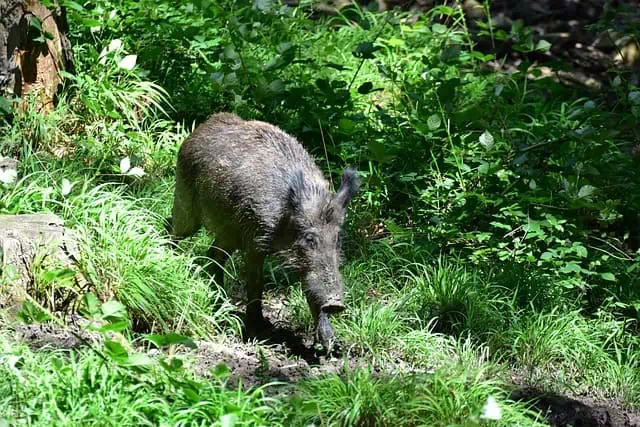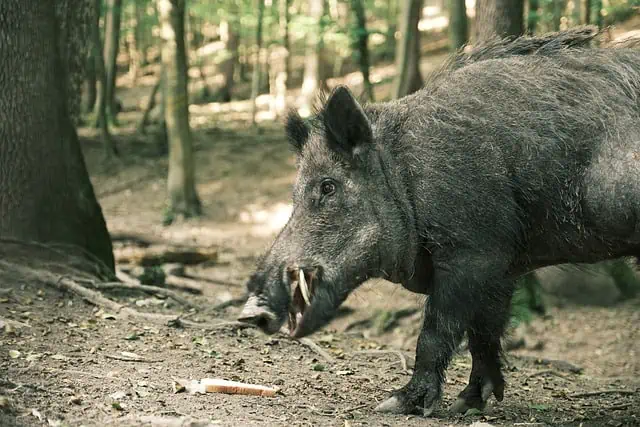Sri Lankan wild boars are fascinating creatures and an integral part of diverse ecosystems across the country. These robust animals of Sri Lanka play a crucial role in maintaining the balance of nature. From their unique appearance to their complex social behavior, Sri Lanka’s wild pigs have attracted a lot of attention from researchers and tourists alike.
Understanding the Sri Lankan Wild Boar
Physical Characteristics

Sri Lankan wild boars are distinguished by their powerful physique and unique characteristics. These creatures differ from their domestic counterparts in some physical ways. Male wild boar are usually bigger than female ones, and adult wild boar in Sri Lanka weigh between 80 and 150 kg on average. they are a swift and formidable breed in the wild, due to their robust bone structure and muscular strength. Their coarse wool coating is dark brown to black, and beneath the skin is a thick layer of fat. They can adapt to the many temperatures on the island thanks to this arrangement, which also protects them in harsh and unforgiving conditions.
The thick skin covers the sharply pointed nose located at the end of their lengthy face and It has enabled them to dig any rough terrain. Moreover, two prominent pointed teeth are often visible on both sides of the mouth in adult male pigs. The size and length of these teeth can give an idea of how old he is.
Habitat
Wild boars in Sri Lanka live in herds in forests, grasslands, and agricultural areas. They are mostly found in wet zone forests but also in other areas such as dry zones and central hills.
Distribution

The lush rainforests of Sri Lanka’s wet zone are an ideal habitat for wild boars, where they have ample food and shelter, but they have adapted to survive even in the arid landscapes of the dry zone. They often frequent thickets and thorn forests in search of food and water, and often hang around human plantations.
Diet
Sri Lankan wild boars are omnivores, depending on vegetation, fruits, roots, insects, and small vertebrates. They also do the work of African hyenas as eating the animal stuff left by leopards. Moreover, They also eat highly venomous snakes like Cobras and Vipers but their venom does not affect wild pigs.
Social Structure and Behavior
Wild boars in Sri Lanka exhibit a complex social structure, often living in small family groups known as sounders. Tightly bonded units usually consist of a mother and her young. Men often live alone. These creatures often spend afternoons under the shade of trees, in swamps, and are more active at dusk and night.
Communication among wild pigs is primarily through vocalizations, body language, and scent marking, and grunting is the predominant method of information transmission. They also use scent glands on their bodies to mark the boundaries of their territory.
Reproduction and Life Cycle
The reproductive cycle of wild boar is closely linked to seasonal changes and environmental factors. Mating usually occurs during the cooler months and females give birth to piglets after a gestation period of about four months.
Males fight for the right to mate with females, and the winner initiates courtship by cooing and startling the female. Once a female becomes pregnant, pregnancy lasts nearly four months and she leaves the group about a day before giving birth to prepare an arboreal nest. An average female gives birth to 4 to 12 cubs and they grow upon milk. young will be weaned after three to four months of growth. Piglets have caramel-colored stripes on their coats to help them camouflage in grasses and forests. At about six months they begin to color and in about a year they take on their rich, dark brown-black color.
Predators and Threats
Natural predators in the life cycle of Sri Lankan wild boars are leopards, jackals, and crocodiles. But also humans hunt them for meat. Since they are known as an animal that severely damages crops in Sri Lanka, the government has issued legal permission to hunt them.
Conservation Status
There are not many organizations or institutions in Sri Lanka for the conservation of wild boars, but facilities have been provided to maintain their usual lifestyle in national parks and sanctuaries across the island. Although it is legal to hunt them, there is no permission to hunt in the national parks, and hunting in the sanctuaries is an offense that can be severely punished. Due to this, they are entitled to some kind of protection
Where to see
To see wild pigs at any time of the year, you can visit national parks like Yala, Wilpattu, and Udawalawa.
Conclusion
Wild boars are a contributor to the island’s rich biodiversity and despite facing many threats and challenges, these resilient animals continue to thrive in diverse habitats. Do your part by prioritizing conservation efforts and promoting coexistence between humans and wildlife, ensuring a bright future for Sri Lankan wild boars and the ecosystems they inhabit.
FAQ
- Are wild boars dangerous to humans?
While wild pigs typically avoid confrontation with humans, they can become aggressive if provoked or cornered, especially females protecting their young.
- Do wild pigs pose a threat to agriculture?
Yes, They can cause significant damage to crops, particularly root vegetables and grains, leading to economic losses for farmers.
- What should I do if I encounter a wild boar in the wild?
If you encounter a wild pig in the wild, it’s best to maintain a safe distance and avoid startling or provoking the animal. Slowly back away and give the boar ample space to retreat.
- Can wild pigs be domesticated?
While Sri Lankan wild boars are not typically domesticated like their domestic counterparts, some individuals have been successfully tamed and raised in captivity under controlled conditions. However, they retain many of their wild instincts and behaviors.

Comment (0)